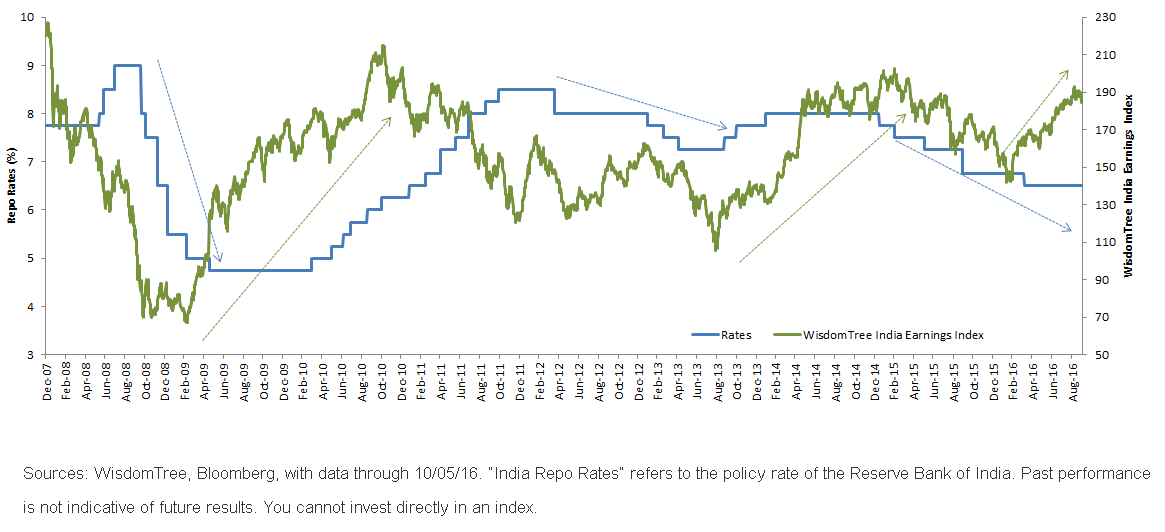India recently appointed a new head of the Reserve Bank of India (RBI), and he did not waste any time in establishing a new policy action.
Below, I highlight the RBI’s latest
monetary policy direction under its new leadership and what it means for domestic growth and global emerging market (EM) investors.
New Leadership, Old Leadership Style
After Dr. Raghuram Rajan’s departure, the appointment of Oxford- and Yale-educated economist Dr. Urjit Patel was widely well received by investors. As the former deputy governor of the RBI, Patel worked closely with Rajan during his tenure. The appointment of Patel was swift and a pure meritocratic and business-oriented decision. By appointing another globally respected economist, one closely associated with the RBI, the Modi government showed again that it means business.
Within a month of taking charge as a governor of the RBI, Patel headed the monetary policy committee meeting on Oct. 4 to decide on the trajectory of India’s short-term rates. Better rains in the middle of the monsoon season leading to increased summer crop production combined with the government’s tight curb on food hoarders helped restrain food prices. This allowed for the August 2016
inflation numbers to stand at 5.05%, about a percentage point below the RBI’s allowable threshold of 6% and in line with the predecided target of 5% for fiscal year 2017.
1
Using the tolerable inflationary environment as an opportunity, Patel’s team unanimously voted for a 25
basis points (bps) cut, making it the sixth consecutive rate cut in a cycle that Rajan started on January 2015. During this cycle, the RBI has consecutively cut 175 bps total.
2
As the monsoon season in India ends this month, a combination of better rains and smart food supply-chain management by the government should continue to put negative pressure on food prices. Thus, in my opinion, investors may look for even lower inflation numbers of around 4% to 4.5% as 2016 comes to an end. More easing by the RBI later this year or early next year cannot be ruled out.
All in all, current rate cuts back up our previous view
that inflation control and growth stimulating monetary policy is a joint objective of the RBI and Modi government. Investors may see an RBI with a new leader, but the leadership style and monetary policy trajectory remain the same.
What Does This Mean for Domestic Growth?
An RBI rate cut sends a strong signal to banks to cut lending rates. October and November mark a festive season in India, which celebrates its biggest festival, Diwali. Diwali is often celebrated with worship of the goddess of wealth, and most households in India buy consumer goods ranging from electronic gadgets to the latest automobiles. Thus, not only is Diwali a busy season for consumer activity but also industrial and manufacturing activities tend to go up.
Because rate cuts by the RBI are passed on by banks to end customers for lower interest rates on personal, auto and home loans, this action is good news for sectors including Consumer Discretionary, Industrials, Manufacturing, Automobiles and even Financials, which benefit from increased economic activity.
RBI as the central bank with the right leadership and ample ammunition can act as much-needed firepower to propel India’s growth engine forward, in our view.
What Does This Mean for Investors?
We want to remind our investors of
a chart that we published in July 2015. At that time, the RBI was early in its rate-cut cycle and we had highlighted the historically favorable impact of rate cuts on Indian equities after a lag. We thought it would be good to check whether the pattern is holding true this time.
The chart below shows that the WisdomTree India Earnings Index (WTIND) has delivered double-digit annual returns with a lag after the RBI’s consecutive rate-cut cycles ended the last two times. So far this year, although the RBI’s rate cuts might not have ended but are arguably in their final stages, WTIND has already delivered over +14%
3 since its lows in February.
WisdomTree India Earnings Index Reacting Positively to Rate Cuts
12/31/07 –10/05/16

 Conclusion
Conclusion
Finally, in the U.S., the Federal Reserve (Fed) has been contemplating a rate hike and it is widely expected that a second hike for 2016 might be around the corner. A rate hike by the U.S. puts pressure on emerging markets, especially EM currencies, because in such an environment investors dump risky asset classes and invest in higher-yielding
Treasuries. Delinking of its policy from the Fed’s rate trajectory is a strong signal of confidence that the RBI has in the rupee and its ability to stabilize the currency if required. India’s foreign exchange (FX) reserves, at $370 billion,
4 are already at their all-time highest and a stable rupee continues to provide opportunities for the RBI to continue increasing its FX reserves by purchasing foreign currency holdings (primarily U.S. dollars).
Strategic allocations to India can capitalize on long-term trends in India’s consumption-fueled economy, led by its surging middle class. However, I believe that as these rate cuts cascade down the economic chain from the central bank to commercial banks to retail consumers, they are bound to help corporate earnings. I therefore also believe there is a strong case now for a tactical investment to India.
1Reserve Bank of India, as of 10/05/16.
2Reserve Bank of India, as of 10/05/16.
3Source: Bloomberg, as of 10/05/16.
4Source: Bank of India, as of 10/05/16.
Important Risks Related to this Article
Investments focused in India increase the impact of events and developments associated with the region, which can adversely affect performance.



 Conclusion
Finally, in the U.S., the Federal Reserve (Fed) has been contemplating a rate hike and it is widely expected that a second hike for 2016 might be around the corner. A rate hike by the U.S. puts pressure on emerging markets, especially EM currencies, because in such an environment investors dump risky asset classes and invest in higher-yielding Treasuries. Delinking of its policy from the Fed’s rate trajectory is a strong signal of confidence that the RBI has in the rupee and its ability to stabilize the currency if required. India’s foreign exchange (FX) reserves, at $370 billion,4 are already at their all-time highest and a stable rupee continues to provide opportunities for the RBI to continue increasing its FX reserves by purchasing foreign currency holdings (primarily U.S. dollars).
Strategic allocations to India can capitalize on long-term trends in India’s consumption-fueled economy, led by its surging middle class. However, I believe that as these rate cuts cascade down the economic chain from the central bank to commercial banks to retail consumers, they are bound to help corporate earnings. I therefore also believe there is a strong case now for a tactical investment to India.
1Reserve Bank of India, as of 10/05/16.
2Reserve Bank of India, as of 10/05/16.
3Source: Bloomberg, as of 10/05/16.
4Source: Bank of India, as of 10/05/16.
Conclusion
Finally, in the U.S., the Federal Reserve (Fed) has been contemplating a rate hike and it is widely expected that a second hike for 2016 might be around the corner. A rate hike by the U.S. puts pressure on emerging markets, especially EM currencies, because in such an environment investors dump risky asset classes and invest in higher-yielding Treasuries. Delinking of its policy from the Fed’s rate trajectory is a strong signal of confidence that the RBI has in the rupee and its ability to stabilize the currency if required. India’s foreign exchange (FX) reserves, at $370 billion,4 are already at their all-time highest and a stable rupee continues to provide opportunities for the RBI to continue increasing its FX reserves by purchasing foreign currency holdings (primarily U.S. dollars).
Strategic allocations to India can capitalize on long-term trends in India’s consumption-fueled economy, led by its surging middle class. However, I believe that as these rate cuts cascade down the economic chain from the central bank to commercial banks to retail consumers, they are bound to help corporate earnings. I therefore also believe there is a strong case now for a tactical investment to India.
1Reserve Bank of India, as of 10/05/16.
2Reserve Bank of India, as of 10/05/16.
3Source: Bloomberg, as of 10/05/16.
4Source: Bank of India, as of 10/05/16.

